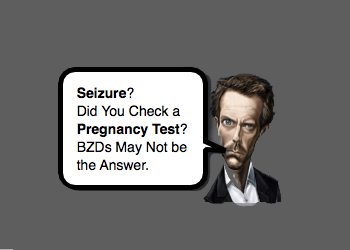Eclampsia in Children

Eclampsia: Basics
- Eclampsia is a leading cause of maternal death worldwide.
- Pre-eclampsia / eclampsia occurs after the 20th week of gestation.
- Eclampsia may occur in postpartum period also. [Al-Safi, 2011; Cantey, 2007]
- Late/Delayed onset postpartum eclampsia = eclampsia >48 hours after delivery
- Seldom develop the classic pre-eclamptic symptoms. [Cantey, 2007]
- Can be challenging to diagnose and requires more vigilance.
- Be wary of complaints of headache in postpartum period.
- Think of Cerebral Venous Thrombosis or postpartum eclampsia!
- Pre-eclampsia is characterized by:
- Hypertension
- SBP >140 and/or DBP >90
- Unfortunately, these levels may not be seen in younger patients, leading to missed diagnosis. [Olaya-Garay, 2017]
- Comparison to baseline blood pressures may be more helpful in children. [Olaya-Garay, 2017]
- Proteinuria
- Generalized edema
- Hypertension
- Eclampsia can be preceded by: [Scribano, 1996]
- Neurologic Symptoms: (commonly precede eclampsia [Cooray, 2011])
- Headaches
- Visual disturbances (ex, blurred vision, blindness, scotomata)
- “Eclampsia” is derived from “eklampsis”: Greek, meaning “to shine forth.” [Elliott, 1989]
- Refers to the flashes of light that patients may describe.
- Epigastric pain
- Hyperreflexia
- Increasing blood pressures
- Neurologic Symptoms: (commonly precede eclampsia [Cooray, 2011])
- Eclampsia is diagnosed when pre-eclampsia is complicated by cerebral dysfunction: [Elliott, 1989]
- Impaired mental status
- Focal neurologic signs
- Seizures
- Coma
- Eclampsia complications
- Pulmonary edema
- Cerebral hemorrhage
- Cerebral hypoxia and edema
- Abruptio placentae
- Acute renal failure
- Hepatic rupture
- Circulatory collapse
- Fetal and/or maternal death
Eclampsia: Risk Factors
- Maternal age
- The extremes of the age range are at highest risk.
- Adolescent age is one of the most important risk factors. [Olaya-Garay, 2017]
- Chronic hypertension
- Gestational diabetes
- Obesity
- Family history of pre-eclampsia/eclampsia
- Nulliparity as well as Multiple gestations
- Urinary tract infection
- Hydatidiform mole
- Fetal hydrops
Eclampsia: Treatment
- ABCDs are always first!
- Check the Sugar! (just in case you forgot to check it during ABCDextrose)
- Anticonvulsants: [ACOG]
- Magnesium Sulfate: 4–6 grams IV bolus over 20 minutes then 1-2 grams/hr infusion
- Benzodiazepines may also be needed for recurrent seizure activity.
- Keppra can be used as second line medication.
- Antihypertensives:[ACOG]
- Labetalol
- Hydralazine
- Delivery of the fetus
- This is the primary treatment for eclampsia.
- Delivery should be the next goal once the mother is more stable. [Elliott, 1989]
Moral of the Morsel
- Seizures in children are common, but don’t get complacent. Think about the causes!
- Few labs are actually useful when managing a seizure. Glucose, Sodium, and Pregnancy Test all potentially change management!
- Consider pediatric pregnancies as a high risk condition.
- Be wary of the postpartum patient with a headache! Scrutinize the blood pressure.
References
Olaya-Garay SX1, Velásquez-Trujillo PA2, Vigil-De Gracia P3. Blood pressure in adolescent patients with pre-eclampsia and eclampsia. Int J Gynaecol Obstet. 2017 Sep;138(3):335-339. PMID: 28602034. [PubMed] [Read by QxMD]
Ananth CV1, Keyes KM, Wapner RJ. Pre-eclampsia rates in the United States, 1980-2010: age-period-cohort analysis. BMJ. 2013 Nov 7;347:f6564. PMID: 24201165. [PubMed] [Read by QxMD]
Fong A1, Chau CT, Pan D, Ogunyemi DA. Clinical morbidities, trends, and demographics of eclampsia: a population-based study. Am J Obstet Gynecol. 2013 Sep;209(3):229. PMID: 23727516. [PubMed] [Read by QxMD]
Cooray SD1, Edmonds SM, Tong S, Samarasekera SP, Whitehead CL. Characterization of symptoms immediately preceding eclampsia. Obstet Gynecol. 2011 Nov;118(5):995-9. PMID: 22015866. [PubMed] [Read by QxMD]
Al-Safi Z1, Imudia AN, Filetti LC, Hobson DT, Bahado-Singh RO, Awonuga AO. Delayed postpartum preeclampsia and eclampsia: demographics, clinical course, and complications. Obstet Gynecol. 2011 Nov;118(5):1102-7. PMID: 21979459. [PubMed] [Read by QxMD]
Cantey JB1, Tecklenburg FW, Titus MO. Late postpartum eclampsia in adolescents. Pediatr Emerg Care. 2007 Jun;23(6):401-3. PMID: 17572526. [PubMed] [Read by QxMD]
Scribano PV1, Selbst SM. Severe eclampsia in an adolescent: a case report and review of the literature. Pediatr Emerg Care. 1996 Dec;12(6):425-7. PMID: 8989791. [PubMed] [Read by QxMD]
Elliott D1, Haller JS. Eclampsia: a pediatric neurologic problem. J Child Neurol. 1989 Jan;4(1):55-60. PMID: 2918212. [PubMed] [Read by QxMD]

